Agent-Based Modeling of Tsunami Evacuation at Figueirinha Beach, Setubal, Portugal
Abstract
1. Introduction
2. Materials and Methods
2.1. Study Area
2.2. Field Survey
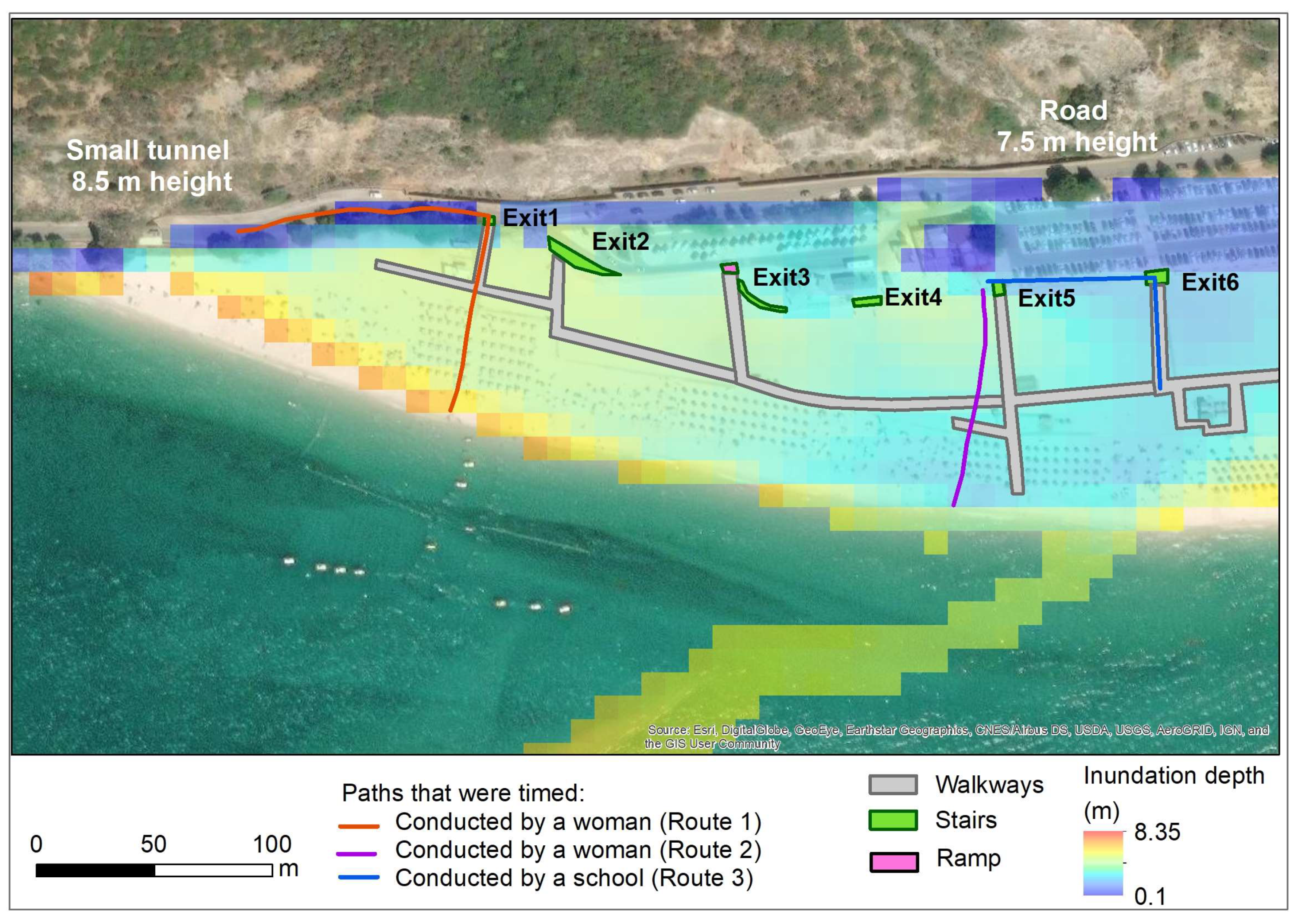
2.3. Data
2.4. The Model
2.4.1. Agents
2.4.2. Landmark-Based Routes
2.4.3. Agent Navigation, Walking Speed, and Collision Management
2.4.4. Group Management
3. Results and Discussion
4. Conclusions
Author Contributions
Funding
Data Availability Statement
Acknowledgments
Conflicts of Interest
Appendix A
| % of Adults | % of Children | % of Total Population | ||||||||||
|---|---|---|---|---|---|---|---|---|---|---|---|---|
| At the Beach | At the Meeting Point | At the Beach | At the Meeting Point | At the Beach | At the Meeting Point | |||||||
| Time (Minutes) | Mean | Stand. Dev. | Mean | Stand. Dev. | Mean | Stand. Dev. | Mean | Stand. Dev. | Mean | Stand. Dev. | Mean | Stand. Dev. |
| 0 | 100.0 | 0.0 | 0.0 | 0.0 | 100.0 | 0.0 | 0.0 | 0.0 | 100.0 | 0.0 | 0.0 | 0.0 |
| 5 | 6.3 | 1.1 | 0.0 | 0.0 | 36.8 | 4.0 | 0.0 | 0.0 | 22.2 | 1.2 | 0.0 | 0.0 |
| 10 | 2.3 | 0.8 | 0.0 | 0.0 | 6.6 | 3.2 | 0.0 | 0.0 | 3.7 | 2.1 | 0.0 | 0.0 |
| 15 | 0.1 | 0.2 | 3.1 | 0.3 | 2.1 | 2.1 | 0.0 | 0.0 | 0.6 | 0.6 | 1.6 | 0.2 |
| 20 | 0.0 | 0.0 | 26.3 | 1.3 | 0.0 | 0.0 | 0.0 | 0.1 | 0.0 | 0.0 | 13.2 | 0.6 |
| 25 | 0.0 | 0.0 | 59.9 | 2.0 | 0.0 | 0.0 | 7.1 | 3.1 | 0.0 | 0.0 | 33.6 | 2.2 |
| 30 | 0.0 | 0.0 | 85.5 | 1.3 | 0.0 | 0.0 | 34.3 | 4.6 | 0.0 | 0.0 | 60.0 | 2.7 |
| 35 | 0.0 | 0.0 | 93.8 | 1.4 | 0.0 | 0.0 | 45.8 | 7.5 | 0.0 | 0.0 | 69.9 | 4.0 |
| 40 | 0.0 | 0.0 | 96.8 | 0.6 | 0.0 | 0.0 | 59.7 | 5.5 | 0.0 | 0.0 | 78.3 | 2.8 |
| 45 | 0.0 | 0.0 | 98.1 | 0.7 | 0.0 | 0.0 | 76.2 | 3.8 | 0.0 | 0.0 | 87.2 | 2.0 |
| 50 | 0.0 | 0.0 | 99.1 | 0.6 | 0.0 | 0.0 | 91.5 | 3.6 | 0.0 | 0.0 | 95.3 | 2.1 |
| 55 | 0.0 | 0.0 | 99.4 | 0.5 | 0.0 | 0.0 | 97.7 | 2.3 | 0.0 | 0.0 | 98.6 | 1.2 |
| % of Adults | % of Children | % of Total Population | ||||||||||
|---|---|---|---|---|---|---|---|---|---|---|---|---|
| At the Beach | At the Meeting Point | At the Beach | At the Meeting Point | At the Beach | At the Meeting Point | |||||||
| Time (Minutes) | Mean | Stand. Dev. | Mean | Stand. Dev. | Mean | Stand. Dev. | Mean | Stand. Dev. | Mean | Stand. Dev. | Mean | Stand. Dev. |
| 0 | 100.0 | 0.1 | 0.0 | 0.0 | 100.0 | 0.0 | 0.0 | 0.0 | 100.0 | 0.0 | 0.0 | 0.0 |
| 5 | 5.1 | 2.1 | 0.0 | 0.0 | 91.7 | 7.0 | 0.0 | 0.0 | 12.4 | 2.5 | 0.0 | 0.0 |
| 10 | 2.0 | 0.9 | 0.0 | 0.0 | 31.2 | 10.0 | 0.0 | 0.0 | 4.5 | 1.6 | 0.0 | 0.0 |
| 15 | 0.2 | 0.3 | 3.5 | 0.8 | 6.8 | 6.1 | 0.0 | 0.0 | 0.8 | 0.8 | 3.2 | 0.7 |
| 20 | 0.0 | 0.0 | 28.7 | 4.5 | 0.0 | 0.0 | 0.0 | 0.0 | 0.0 | 0.0 | 26.3 | 4.2 |
| 25 | 0.0 | 0.0 | 62.0 | 3.8 | 0.0 | 0.0 | 5.9 | 5.6 | 0.0 | 0.0 | 57.2 | 3.9 |
| 30 | 0.0 | 0.0 | 87.0 | 3.1 | 0.0 | 0.0 | 28.8 | 13.7 | 0.0 | 0.0 | 82.1 | 3.9 |
| 35 | 0.0 | 0.0 | 96.0 | 1.3 | 0.0 | 0.0 | 53.2 | 19.5 | 0.0 | 0.0 | 92.4 | 2.5 |
| 40 | 0.0 | 0.0 | 99.0 | 0.5 | 0.0 | 0.0 | 75.1 | 12.6 | 0.0 | 0.0 | 96.9 | 1.5 |
| 45 | 0.0 | 0.0 | 99.7 | 0.2 | 0.0 | 0.0 | 88.8 | 8.9 | 0.0 | 0.0 | 98.8 | 0.9 |
| 50 | 0.0 | 0.0 | 99.8 | 0.3 | 0.0 | 0.0 | 89.0 | 12.1 | 0.0 | 0.0 | 98.9 | 1.3 |
| % of Adults | % of Children | % of Total Population | ||||||||||
|---|---|---|---|---|---|---|---|---|---|---|---|---|
| At the Beach | At the Meeting Point | At the Beach | At the Meeting Point | At the Beach | At the Meeting Point | |||||||
| Time (Minutes) | Mean | Stand. Dev. | Mean | Stand. Dev. | Mean | Stand. Dev. | Mean | Stand. Dev. | Mean | Stand. Dev. | Mean | Stand. Dev. |
| 0 | 100.0 | 0.0 | 0.0 | 0.0 | 100.0 | 0.0 | 0.0 | 0.0 | 100.0 | 0.0 | 0.0 | 0.0 |
| 5 | 10.9 | 2.3 | 0.0 | 0.0 | 42.7 | 6.3 | 0.0 | 0.0 | 31.2 | 4.9 | 0.0 | 0.0 |
| 10 | 4.1 | 1.5 | 0.0 | 0.0 | 9.4 | 2.5 | 0.0 | 0.0 | 7.5 | 2.0 | 0.0 | 0.0 |
| 15 | 0.7 | 0.5 | 2.5 | 0.5 | 2.6 | 1.1 | 0.0 | 0.0 | 1.9 | 0.8 | 0.9 | 0.2 |
| 20 | 0.0 | 0.0 | 23.8 | 2.0 | 0.1 | 0.1 | 0.0 | 0.1 | 0.0 | 0.1 | 8.6 | 0.7 |
| 25 | 0.0 | 0.0 | 58.7 | 1.7 | 0.1 | 0.1 | 2.2 | 1.3 | 0.0 | 0.1 | 22.6 | 1.1 |
| 30 | 0.0 | 0.0 | 81.3 | 1.5 | 0.0 | 0.0 | 11.9 | 2.7 | 0.0 | 0.0 | 36.9 | 2.0 |
| 35 | 0.0 | 0.0 | 92.3 | 1.7 | 0.0 | 0.0 | 47.8 | 8.1 | 0.0 | 0.0 | 63.9 | 5.7 |
| 40 | 0.0 | 0.0 | 96.9 | 0.8 | 0.0 | 0.0 | 76.2 | 6.0 | 0.0 | 0.0 | 83.7 | 4.1 |
| 45 | 0.0 | 0.0 | 98.7 | 0.2 | 0.0 | 0.0 | 92.9 | 2.6 | 0.0 | 0.0 | 95.0 | 1.7 |
| 50 | 0.0 | 0.0 | 99.2 | 0.1 | 0.0 | 0.0 | 98.3 | 0.4 | 0.0 | 0.0 | 98.6 | 0.3 |
| 55 | 0.0 | 0.0 | 99.3 | 0.0 | 0.0 | 0.0 | 99.3 | 0.7 | 0.0 | 0.0 | 99.3 | 0.5 |
| % of Adults | % of Children | % of Total Population | ||||||||||
|---|---|---|---|---|---|---|---|---|---|---|---|---|
| At the Beach | At the Meeting Point | At the Beach | At the Meeting Point | At the Beach | At the Meeting Point | |||||||
| Time (Minutes) | Mean | Stand. Dev. | Mean | Stand. Dev. | Mean | Stand. Dev. | Mean | Stand. Dev. | Mean | Stand. Dev. | Mean | Stand. Dev. |
| 0 | 100.0 | 0.0 | 0.0 | 0.0 | 100.0 | 0.0 | 0.0 | 0.0 | 100.0 | 0.0 | 0.0 | 0.0 |
| 5 | 13.6 | 3.0 | 0.0 | 0.0 | 93.3 | 3.6 | 0.0 | 0.0 | 20.4 | 2.9 | 0.0 | 0.0 |
| 10 | 2.5 | 0.5 | 0.0 | 0.0 | 38.9 | 10.5 | 0.0 | 0.0 | 5.6 | 1.2 | 0.0 | 0.0 |
| 15 | 0.3 | 0.3 | 3.0 | 0.6 | 6.7 | 2.8 | 0.0 | 0.0 | 0.9 | 0.4 | 2.7 | 0.6 |
| 20 | 0.0 | 0.0 | 21.1 | 1.0 | 1.5 | 2.3 | 0.2 | 0.5 | 0.1 | 0.2 | 19.3 | 0.9 |
| 25 | 0.0 | 0.0 | 57.2 | 1.6 | 0.0 | 0.0 | 8.5 | 5.5 | 0.0 | 0.0 | 53.0 | 1.7 |
| 30 | 0.0 | 0.0 | 82.2 | 1.9 | 0.0 | 0.0 | 28.9 | 4.9 | 0.0 | 0.0 | 77.6 | 2.1 |
| 35 | 0.0 | 0.0 | 94.3 | 0.7 | 0.0 | 0.0 | 59.8 | 9.6 | 0.0 | 0.0 | 91.3 | 0.5 |
| 40 | 0.0 | 0.0 | 98.2 | 0.4 | 0.0 | 0.0 | 80.2 | 3.3 | 0.0 | 0.0 | 96.6 | 0.6 |
| 45 | 0.0 | 0.0 | 99.4 | 0.4 | 0.0 | 0.0 | 91.7 | 2.6 | 0.0 | 0.0 | 98.8 | 0.6 |
| 50 | 0.0 | 0.0 | 99.8 | 0.3 | 0.0 | 0.0 | 97.2 | 2.7 | 0.0 | 0.0 | 99.5 | 0.4 |
| % of Adults | % of Children | % of Total Population | ||||||||||
|---|---|---|---|---|---|---|---|---|---|---|---|---|
| At the Beach | At the Meeting Point | At the Beach | At the Meeting Point | At the Beach | At the Meeting Point | |||||||
| Time (Minutes) | Mean | Stand. Dev. | Mean | Stand. Dev. | Mean | Stand. Dev. | Mean | Stand. Dev. | Mean | Stand. Dev. | Mean | Stand. Dev. |
| 0 | 100.0 | 0.0 | 0.0 | 0.0 | 100.0 | 0.0 | 0.0 | 0.0 | 100.0 | 0.0 | 0.0 | 0.0 |
| 5 | 12.0 | 2.8 | 0.0 | 0.0 | 87.7 | 3.7 | 0.0 | 0.0 | 18.5 | 2.9 | 0.0 | 0.0 |
| 10 | 2.8 | 1.9 | 0.0 | 0.0 | 36.5 | 9.0 | 0.0 | 0.0 | 5.7 | 2.4 | 0.0 | 0.0 |
| 15 | 0.6 | 0.4 | 3.2 | 0.4 | 7.9 | 5.7 | 0.0 | 0.0 | 1.2 | 0.9 | 3.0 | 0.4 |
| 20 | 0.1 | 0.1 | 19.6 | 1.1 | 1.3 | 1.9 | 0.0 | 0.0 | 0.2 | 0.2 | 17.9 | 1.0 |
| 25 | 0.0 | 0.0 | 56.5 | 1.7 | 0.2 | 0.4 | 5.2 | 4.3 | 0.0 | 0.0 | 52.1 | 1.6 |
| 30 | 0.0 | 0.0 | 84.2 | 0.9 | 0.0 | 0.0 | 30.4 | 5.4 | 0.0 | 0.0 | 79.6 | 1.2 |
| 35 | 0.0 | 0.0 | 95.5 | 0.5 | 0.0 | 0.0 | 58.7 | 3.0 | 0.0 | 0.0 | 92.3 | 0.7 |
| 40 | 0.0 | 0.0 | 98.4 | 0.2 | 0.0 | 0.0 | 75.0 | 8.2 | 0.0 | 0.0 | 96.4 | 0.8 |
| 45 | 0.0 | 0.0 | 99.5 | 0.1 | 0.0 | 0.0 | 88.8 | 0.6 | 0.0 | 0.0 | 98.6 | 0.1 |
| % of Adults | % of Children | % of Total Population | ||||||||||
|---|---|---|---|---|---|---|---|---|---|---|---|---|
| At the Beach | At the Meeting Point | At the Beach | At the Meeting Point | At the Beach | At the Meeting Point | |||||||
| Time (Minutes) | Mean | Stand. Dev. | Mean | Stand. Dev. | Mean | Stand. Dev. | Mean | Stand. Dev. | Mean | Stand. Dev. | Mean | Stand. Dev. |
| 0 | 100.0 | 0.0 | 0.0 | 0.0 | 100.0 | 0.0 | 0.0 | 0.0 | 100.0 | 0.0 | 0.0 | 0.0 |
| 5 | 4.7 | 0.9 | 0.0 | 0.0 | 87.3 | 7.8 | 0.0 | 0.0 | 11.5 | 1.3 | 0.0 | 1.3 |
| 10 | 1.2 | 0.6 | 0.0 | 0.0 | 27.9 | 9.9 | 0.0 | 0.0 | 3.4 | 1.3 | 0.0 | 1.3 |
| 15 | 0.4 | 0.3 | 3.6 | 0.7 | 10.3 | 4.1 | 0.0 | 0.0 | 1.2 | 0.6 | 3.3 | 0.6 |
| 20 | 0.1 | 0.1 | 29.4 | 2.0 | 2.4 | 5.4 | 0.6 | 1.4 | 0.3 | 0.6 | 27.0 | 0.6 |
| 25 | 0.0 | 0.0 | 62.9 | 2.2 | 0.0 | 0.0 | 7.3 | 7.6 | 0.0 | 0.0 | 58.3 | 0.0 |
| 30 | 0.0 | 0.0 | 87.6 | 2.0 | 0.0 | 0.0 | 31.5 | 14.8 | 0.0 | 0.0 | 83.0 | 0.0 |
| 35 | 0.0 | 0.0 | 96.3 | 1.0 | 0.0 | 0.0 | 55.8 | 13.0 | 0.0 | 0.0 | 92.9 | 0.0 |
| 40 | 0.0 | 0.0 | 98.7 | 0.4 | 0.0 | 0.0 | 74.5 | 9.7 | 0.0 | 0.0 | 96.7 | 0.0 |
| 45 | 0.0 | 0.0 | 99.3 | 0.6 | 0.0 | 0.0 | 83.3 | 12.5 | 0.0 | 0.0 | 98.0 | 0.0 |
| 50 | 0.0 | 0.0 | 99.7 | 0.4 | 0.0 | 0.0 | 83.3 | 10.7 | 0.0 | 0.0 | 98.4 | 0.0 |
References
- Santos, A.; Sousa, N.; Kremers, H.; Bucho, J.L. Building resilient urban communities: The case study of Setubal Municipality. Portugal. Geosciences 2020, 10, 243. [Google Scholar] [CrossRef]
- United Nations Office for Disaster Reduction UNDRR. Sendai Framework for Disaster Risk Reduction 2015–2030; UNISDR: Geneva, Switzerland, 2015; p. 32. Available online: https://www.undrr.org/publication/sendai-framework-disaster-risk-reduction-2015-2030 (accessed on 15 July 2023).
- National Authority of Emergency and Civil Protection. General Law. 2023. Available online: https://prociv.gov.pt/pt/legislacao/ (accessed on 15 July 2023). (In Portuguese)
- National Platform for Disaster Risk Reduction. 2023. Available online: https://www.pnrrc.pt/ (accessed on 15 July 2023). (In Portuguese).
- Aleluia, A. Digital Cartography of the Setubal Municipality at Scale 1:10,000; Department of Urbanism, Cabinet of Geographical Information System; Setubal City Hall: Setubal, Portugal, 2011. (In Portuguese) [Google Scholar]
- Sousa, N. The Civil Planning of Emergency in the New Paradigm of Safety. Master’s Thesis, University of Lisbon, Lisbon, Portugal, 2016. Available online: https://www.repository.utl.pt/handle/10400.5/11567 (accessed on 15 July 2023). (In Portuguese).
- European Commission. Seveso Directive. 2019. Available online: https://ec.europa.eu/environment/seveso/legislation.htm (accessed on 15 July 2023).
- Santos, A.; Fonseca, N.; Queirós, M.; Zêzere, J.L.; Bucho, J.L. Implementation of Tsunami Evacuation Maps at Setubal Municipality. Portugal. Geosciences 2017, 7, 116. [Google Scholar] [CrossRef]
- Kobes, M.; Helsloot, I.; de Vries, B.; Post, J.G.; Oberijé, N.; Groenewegen, K. Way finding during fire evacuation; an analysis of unannounced fire drills in a hotel at night. Build. Environ. 2010, 45, 537–548. [Google Scholar] [CrossRef]
- Bird, D.K.; Chagué-Goff, C.; Gero, A. Human Response to Extreme Events: A review of three post-tsunami disaster case studies. Aust. Geogr. 2011, 42, 225–239. [Google Scholar] [CrossRef]
- Dengler, L.; Goltz, J.; Fenton, J.; Miller, K.; Wilson, R. Building tsunami-resilient communities in the United States: An example from California. TsuInfo Alert 2011, 13, 2. [Google Scholar]
- SMPCB. MITREX Exercise; Setubal City Hall: Setubal, Portugal, 2012; p. 487. (In Portuguese) [Google Scholar]
- Setubal City Hall. Bocage 2013. 2013. Available online: https://www.youtube.com/watch?v=Z5tRO0ldcrY (accessed on 15 July 2023). (In Portuguese).
- Gu, Z.; Liu, Z.; Shiwakoti, N.; Yang, M. Video-based analysis of school students’ emergency evacuation behavior in earthquakes. Int. J. Disaster Risk Reduct. 2016, 18, 1–11. [Google Scholar] [CrossRef]
- David, N.; Fachada, N.; Rosa, A.C. Verifying and Validating Simulations. In Simulating Social Complexity. Understanding Complex Systems, 1st ed.; Edmonds, B., Meyer, R., Eds.; Springer Nature: Cham, Switzerland, 2017; pp. 173–204. [Google Scholar] [CrossRef]
- Edmonds, B.; Meyer, R. Simulating Social Complexity; Springer Nature: Cham, Switzerland, 2017; p. 409. [Google Scholar] [CrossRef]
- Axelrod, R. The Evolution of Cooperation; Basic Books: New York, NY, USA, 1984; ISBN 978-0-465-02121-5. Available online: http://bert.stuy.edu/pbrooks/spring2015/materials/HumanReasoning-2/Axelrod_Robert_The_Evolution_of_Cooperation.pdf (accessed on 15 July 2023).
- Antelmi, A.; Cordasco, G.; D’Ambrosio, G.; De Vinco, D.; Spagnuolo, C. Experimenting with Agent-Based Model Simulation Tools. Appl. Sci. 2022, 13, 13. [Google Scholar] [CrossRef]
- Filomena, G.; Verstegen, J.A. Modelling the effect of landmarks on pedestrian dynamics in urban environments. Comput. Environ. Urban Syst. 2021, 86, 101573. [Google Scholar] [CrossRef]
- Jumadi; Heppenstall, A.; Malleson, N.; Carver, S.; Quincey, D.; Manville, V. Modelling Individual Evacuation Decisions during Natural Disasters: A Case Study of Volcanic Crisis in Merapi. Indonesia. Geosciences. 2018, 8, 196. [Google Scholar] [CrossRef]
- Goto, Y.; Affan, M.; Agussabti; Nurdin, Y.; Yuliana, D.K.; Ardiansyah. Tsunami evacuation simulation for disaster education and city planning. J. Disaster Res. 2012, 7, 92–101. [Google Scholar] [CrossRef]
- Mls, K.; Kořínek, M.; Štekerová, K.; Tučník, P.; Bureš, V.; Čech, P.; Husáková, M.; Mikulecký, P.; Nacházel, P.; Ponce, D.; et al. Agent-based models of human response to natural hazards: Systematic review of tsunami evacuation. Nat. Hazards 2023, 115, 1887–1908. [Google Scholar] [CrossRef] [PubMed]
- Mas, E.; Koshimura, S.; Imamura, F.; Suppasri, A.; Muhari, A.; Adriano, B. Recent Advances in Agent-Based Tsunami Evacuation Simulations: Case Studies in Indonesia, Thailand. Japan and Peru. Pure Appl. Geophys. 2015, 172, 3409–3424. [Google Scholar] [CrossRef]
- Wang, Z.; Jia, G. Simulation-Based and Risk-Informed Assessment of the Effectiveness of Tsunami Evacuation Routes Using Agent-Based Modeling: A Case Study of Seaside. Oregon. Int. J. Disaster Risk Sci. 2022, 13, 66–86. [Google Scholar] [CrossRef]
- ANPC. Estudo do Risco Sísmico e de Tsunami do Algarve. 2010; 85p. Available online: https://prociv.gov.pt/pt/home/ (accessed on 15 July 2023). (In Portuguese)
- INE. Preliminary Census Data of the Resident Population in Setubal in 2020 and 2021. 2022. Available online: https://www.ine.pt (accessed on 15 July 2023). (In Portuguese).
- Cândido, E. Modelação Baseada em Agentes da Evacuação da Praia da Figueirinha. Master’s Thesis, Iscte—Instituto Universitário de Lisboa, Lisboa, Portugal, 2022. Available online: http://hdl.handle.net/10071/27712 (accessed on 15 July 2023).
- Kazil, J.; Masad, D.; Crooks, A. Utilizing Python for Agent-Based Modeling: The Mesa Framework. In Social, Cultural, and Behavioral Modeling, Proceedings of the 13th International Conference, SBP-BRiMS 2020, Washington, DC, USA, 18–21 October 2020; Thomson, R., Bisgin, H., Dancy, C., Hyder, A., Hussain, M., Eds.; Lecture Notes in Computer Science; Springer: Cham, Switzerland, 2020; Volume 12268. [Google Scholar] [CrossRef]
- Wang, B.; Hess, V.; Crooks, A. Mesa-Geo: A GIS Extension for the Mesa Agent Based Modeling Framework in Python. In Proceedings of the 5th ACM SIGSPATIAL International Workshop on GeoSpatial Simulation, Seattle, WA, USA, 1 November 2022. [Google Scholar] [CrossRef]
- Stern, R. Multi-Agent Path Finding—An Overview. In Artificial Intelligence; Osipov, G., Panov, A., Yakovlev, K., Eds.; Springer Nature: Cham, Switzerland, 2019; Volume 11866, pp. 96–115. [Google Scholar] [CrossRef]
- Sohn, S.S.; DeStefani, S.; Kapadia, M. Dynamic cognitive maps for agent landmark navigation in unseen environments. In Proceedings of the 11th ACM SIGGRAPH Conference on Motion Interaction and Games, Limassol, Cyprus, 8–10 November 2018. [Google Scholar] [CrossRef]
- Yesiltepe, D.; Conroy Dalton, R.; Ozbil Torun, A. Landmarks in wayfinding: A review of the existing literature. Cogn. Process. 2021, 22, 369–410. [Google Scholar] [CrossRef]
- Röser, F.A. Cognitive Observer-Based Landmark-Preference Model. KI-Künstliche Intell. 2017, 31, 169–171. [Google Scholar] [CrossRef]
- Schimpl, M.; Moore, C.; Lederer, C.; Neuhaus, A.; Sambrook, J.; Danesh, J.; Ouwehand, W.; Daumer, M. Association between walking speed and age in healthy. free-living individuals using mobile accelerometry—A cross-sectional study. PLoS ONE 2011, 6, e23299. [Google Scholar] [CrossRef]
- Silva, A.M.; da Silva, J.P.; da Cunha, J.R. Estimation of pedestrian walking speeds on footways. In Proceedings of the Institution of Civil Engineers-Municipal Engineer; Thomas Telford Ltd.: London, UK, 2014; Volume 167, pp. 32–43. [Google Scholar] [CrossRef]
- Nazir, M.; Razi, K.; Hossain, Q.; Adhikary, S. Pedestrian Flow Characteristics at Walkways in Rajshahi Metropolitan City of Bangladesh. In Proceedings of the 2nd International Conference on Civil Engineering for Sustainable Development (ICCESD-2014), KUET, Khulna, Bangladesh, 14–16 February 2014; ISBN 978-984-33-6373-2 (CD-ROM). Available online: https://www.researchgate.net/publication/321759346_Pedestrian_Flow_Characteristics_at_Walkways_in_Rajshahi_Metropolitan_City_of_Bangladesh (accessed on 15 July 2023).
- Leicht, A.; Crowther, R. Pedometer Accuracy during Walking over Different Surfaces. Med. Sci. Sports Exerc. 2007, 39, 1847–1850. [Google Scholar] [CrossRef]
- Aghabayk, K.; Parishad, N.; Shiwakoti, N. Investigation on the impact of walkways slope and pedestrians physical characteristics on pedestrians normal walking and jogging speeds. Saf. Sci. 2021, 133, 105012. [Google Scholar] [CrossRef]
- Yu, J.; Petnga, L. Space-based Collision Avoidance Framework for Autonomous Vehicles. Procedia Comput. Sci. 2018, 140, 37–45. [Google Scholar] [CrossRef]
- Foudil, C.; Djedi, N.; Sanza, C.; Duthen, Y. Path Finding and Collision Avoidance in Crowd Simulation. J. Comput. Inf. Technol. 2009, 3, 217–228. [Google Scholar] [CrossRef][Green Version]
- Fraser, S.A.; Wood, N.J.; Johnston, D.M.; Leonard, G.S.; Greening, P.D.; Rossetto, T. Variable population exposure and distributed travel speeds in least-cost tsunami evacuation modelling. Nat. Hazards Earth Syst. Sci. 2014, 14, 2975–2991. [Google Scholar] [CrossRef]
- Kohns, J.; Stempniewski, L.; Stark, A. Fragility Functions for Reinforced Concrete Structures Based on Multiscale Approach for Earthquake Damage Criteria. Buildings 2022, 12, 1253. [Google Scholar] [CrossRef]
- Koshimura, S.; Oie, T.; Yanagisawa, H.; Imamura, F. Developing Fragility Functions for Tsunami Damage Estimation Using Numerical Model and Post-tsunami Data from Banda Aceh Indonesia. Coast. Eng, J. 2009, 51, 243–273. [Google Scholar] [CrossRef]
- Mizutani, A.; Yomogida, K.; Tanioka, Y. Early tsunami detection with near-fault ocean-bottom pressure gauge records based on the comparison with seismic data. J. Geophys. Res Ocean. 2020, 125, e2020JC016275. [Google Scholar] [CrossRef]
- Wang, Y.; Tsushima, H.; Satake, K.; Navarrete, P. Review on recent progress in near-field tsunami forecasting using offshore tsunami measurements: Source inversion and data assimilation. Pure Appl. Geophys. 2021, 178, 5109–5128. [Google Scholar] [CrossRef]
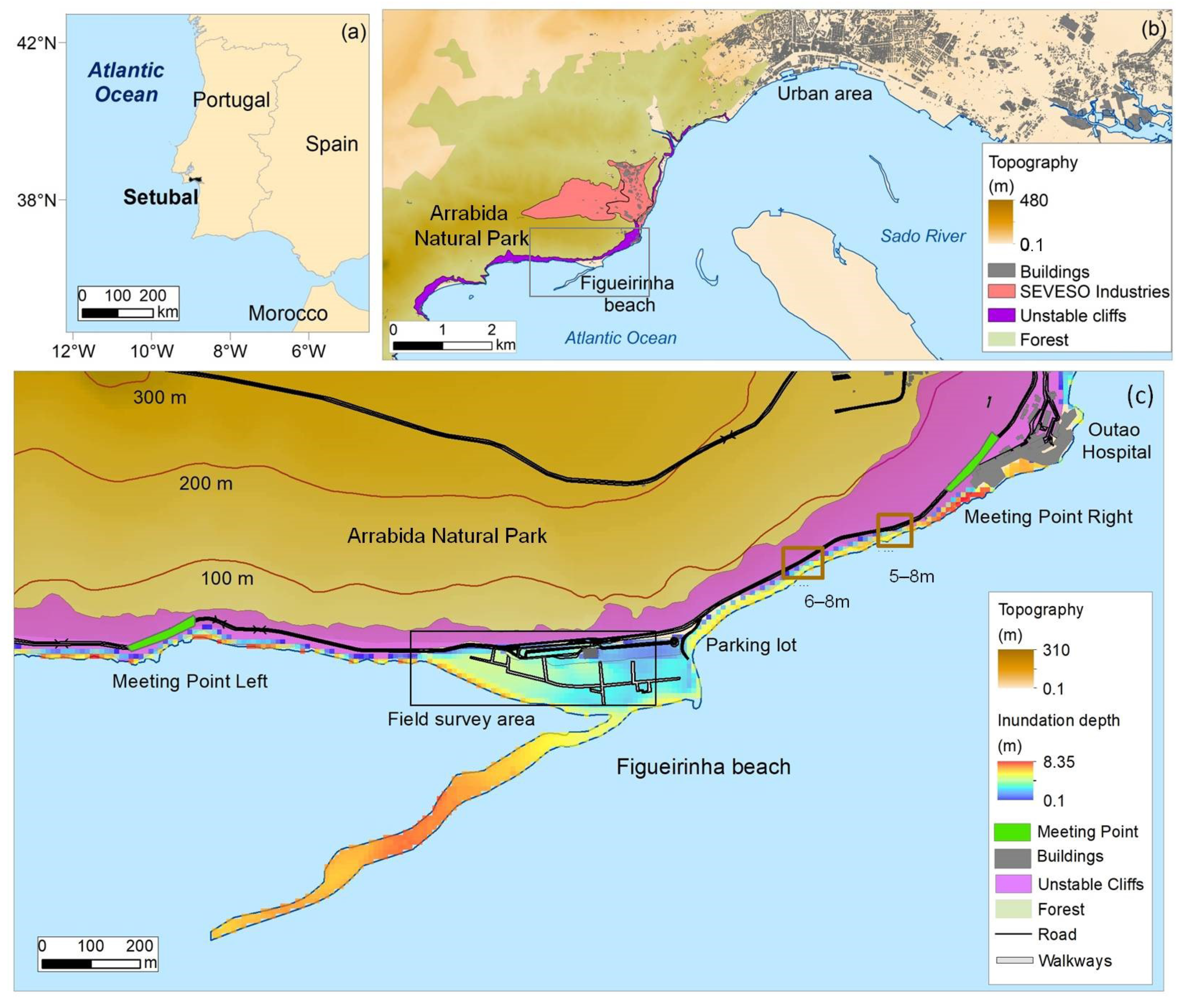

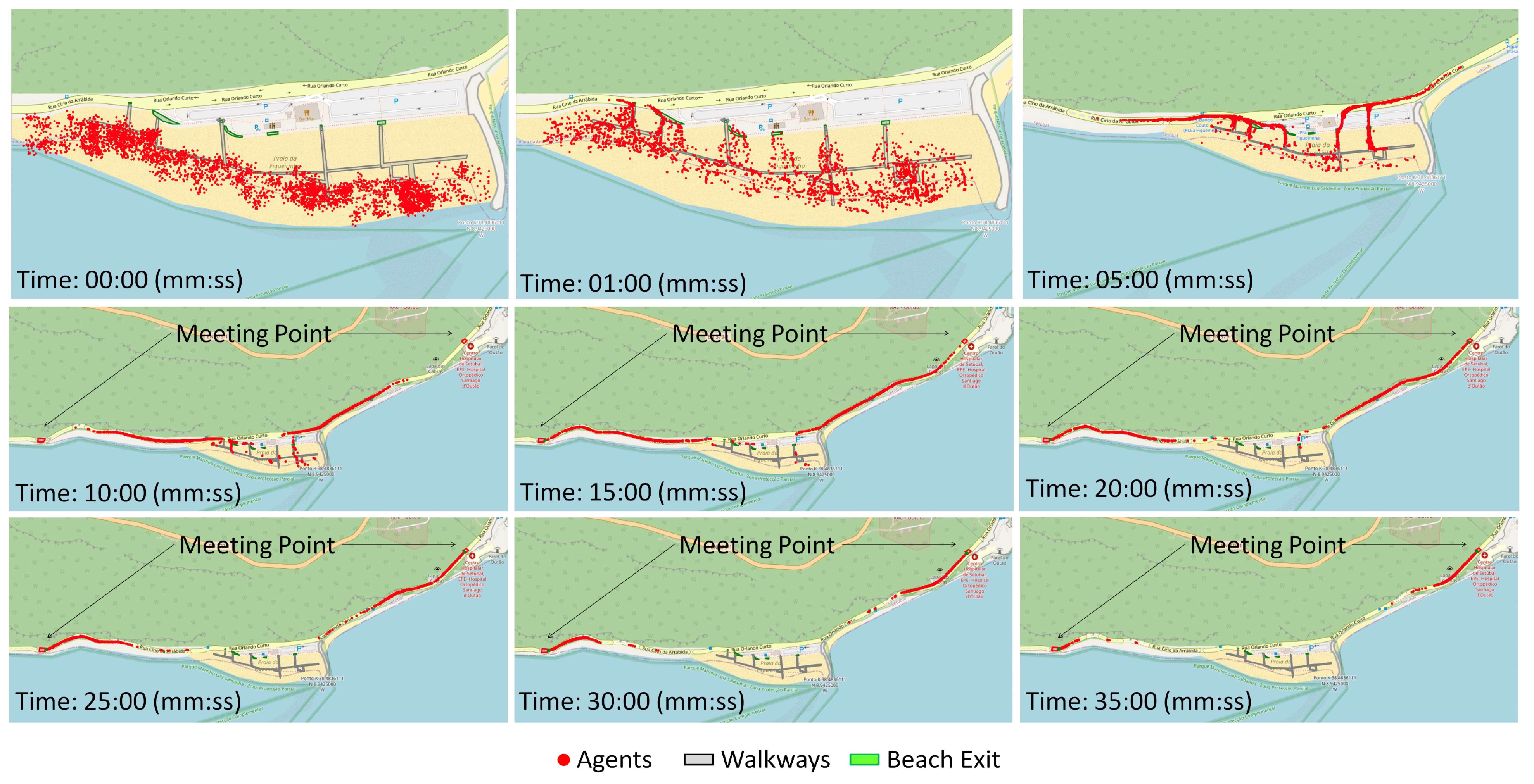
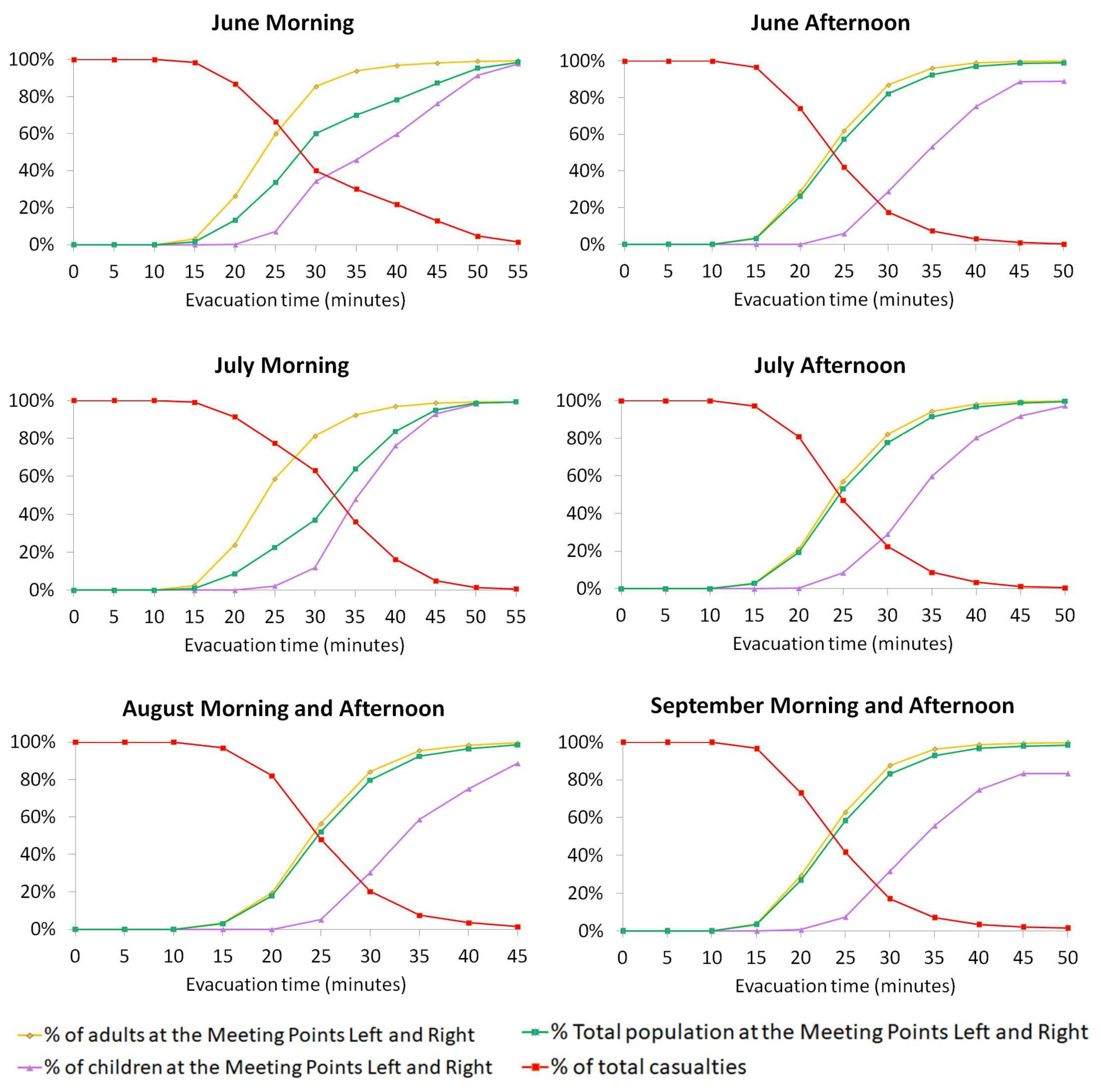
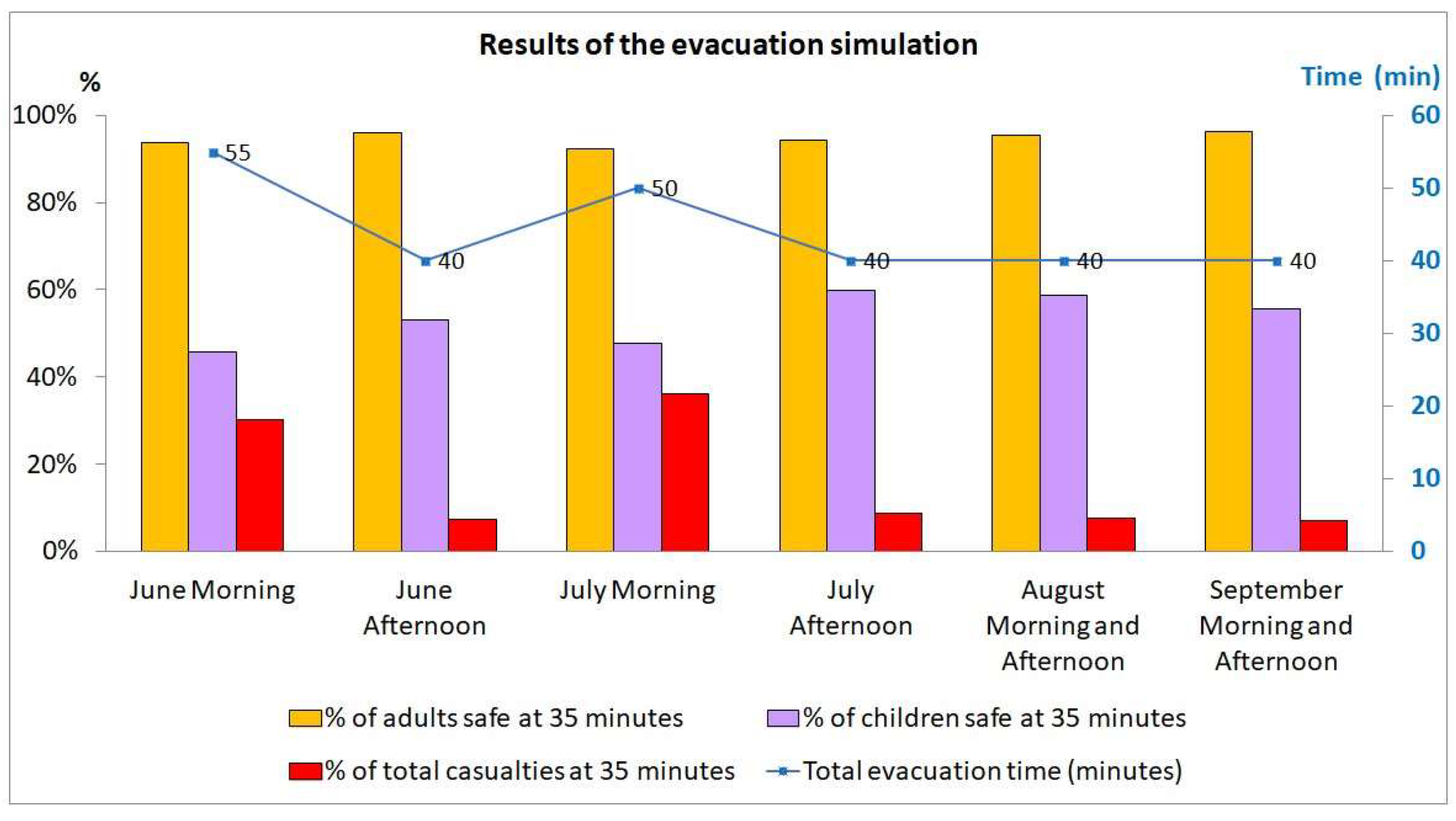
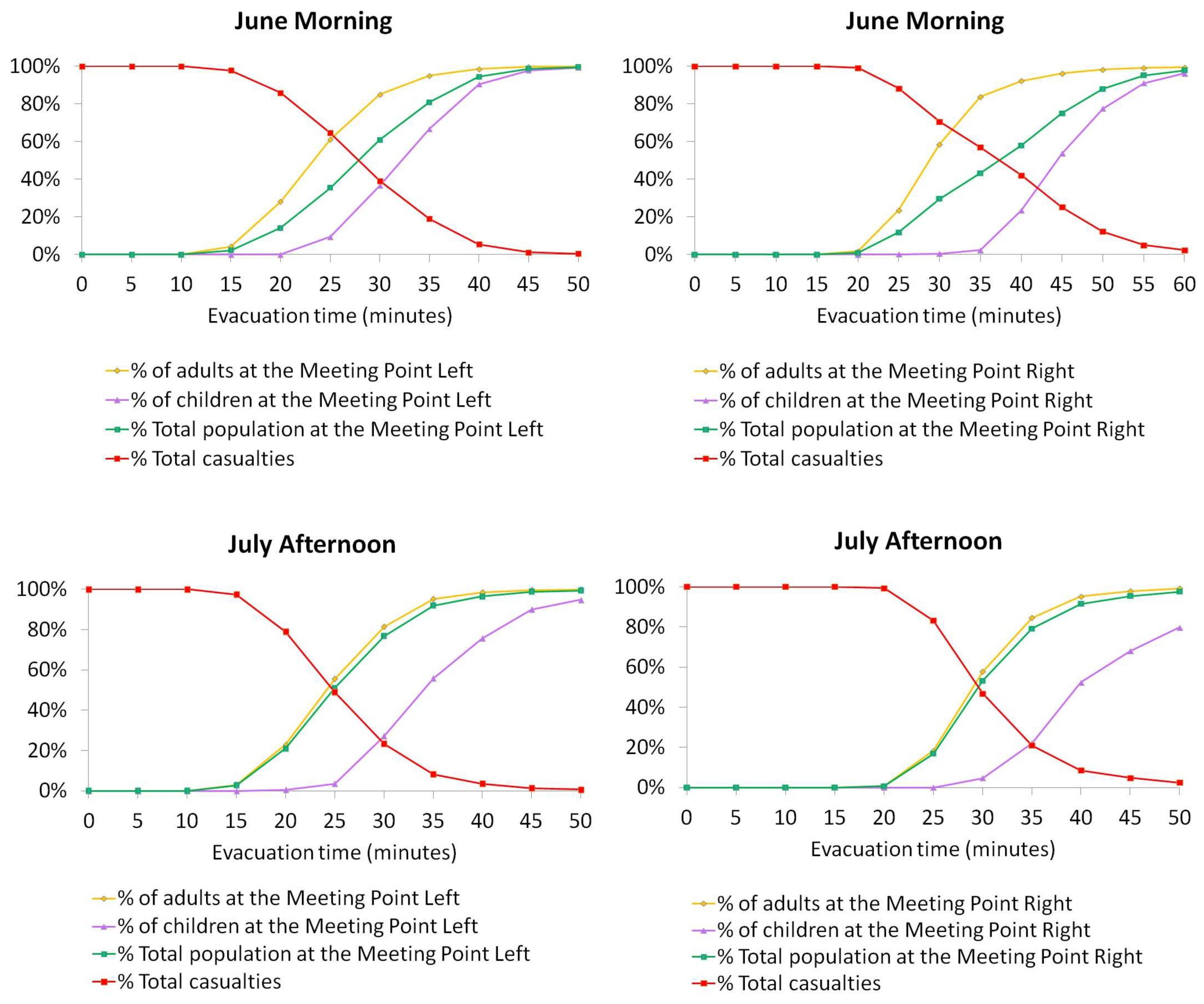
| Meeting Point | Exit 1 | Exit 2 | Exit 3 | Exit 4 | Exit 5 | Exit 6 |
|---|---|---|---|---|---|---|
| Left | 757 | 794 | 869 | 944 | 988 | 1068 |
| Right | 1084 | 1050 | 992 | 967 | 902 | 853 |
| Month | Period | Public Buses C/A/T | Cars C/A/T | School Buses C/A/T | Total C/A/T |
|---|---|---|---|---|---|
| June | Morning | 11/122/133 | 30/321/351 | 424/21/445 | 465/464/929 |
| Afternoon | 11/122/133 | 30/321/351 | 0/0/0 | 41/443/484 | |
| July | Morning | 60/634/694 | 32/344/376 | 1811/91/1902 | 1903/1069/2972 |
| Afternoon | 60/634/694 | 32/344/376 | 0/0/0 | 92/978/1070 | |
| August | Morning and afternoon | 66/699/765 | 39/413/452 | 0/0/0 | 105/1112/1217 |
| September | Morning and afternoon | 11/120/131 | 23/244/267 | 0/0/0 | 34/364/398 |
| Scenario | Meeting Point | % of Children | % of Adults | % of Total Population |
|---|---|---|---|---|
| June morning (929 agents, with school groups) | Left | 33.2 | 5.0 | 19.0 |
| Both | 54.2 | 6.2 | 30.1 | |
| Right | 97.7 | 16.3 | 56.9 | |
| July afternoon (1070 agents, without school groups) | Left | 44.2 | 4.8 | 8.2 |
| Both | 40.2 | 5.7 | 8.7 | |
| Right | 77.9 | 15.5 | 20.9 |
Disclaimer/Publisher’s Note: The statements, opinions and data contained in all publications are solely those of the individual author(s) and contributor(s) and not of MDPI and/or the editor(s). MDPI and/or the editor(s) disclaim responsibility for any injury to people or property resulting from any ideas, methods, instructions or products referred to in the content. |
© 2023 by the authors. Licensee MDPI, Basel, Switzerland. This article is an open access article distributed under the terms and conditions of the Creative Commons Attribution (CC BY) license (https://creativecommons.org/licenses/by/4.0/).
Share and Cite
Santos, A.; David, N.; Perdigão, N.; Cândido, E. Agent-Based Modeling of Tsunami Evacuation at Figueirinha Beach, Setubal, Portugal. Geosciences 2023, 13, 327. https://doi.org/10.3390/geosciences13110327
Santos A, David N, Perdigão N, Cândido E. Agent-Based Modeling of Tsunami Evacuation at Figueirinha Beach, Setubal, Portugal. Geosciences. 2023; 13(11):327. https://doi.org/10.3390/geosciences13110327
Chicago/Turabian StyleSantos, Angela, Nuno David, Nelson Perdigão, and Eduardo Cândido. 2023. "Agent-Based Modeling of Tsunami Evacuation at Figueirinha Beach, Setubal, Portugal" Geosciences 13, no. 11: 327. https://doi.org/10.3390/geosciences13110327
APA StyleSantos, A., David, N., Perdigão, N., & Cândido, E. (2023). Agent-Based Modeling of Tsunami Evacuation at Figueirinha Beach, Setubal, Portugal. Geosciences, 13(11), 327. https://doi.org/10.3390/geosciences13110327








